8 /10 1 Votes
7.7/10 FreeROMS Initial release date 14 December 1996 | 4.5/5 Emuparadise 3.8/5 Complete ROMS Composer(s) Kenta Nagata Genre Racing video game | |||||||||||||||||||||||||||||||||
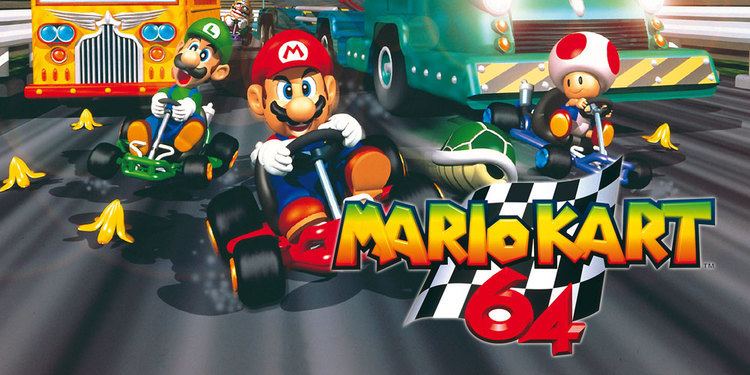 | ||||||||||||||||||||||||||||||||||
Mode(s) Single-player, multiplayer Developers Nintendo, Nintendo Entertainment Analysis & Development Similar Mario Kart games, Nintendo games, Racing video games | ||||||||||||||||||||||||||||||||||
Nintendo 64 longplay 002 mario kart 64
Mario Kart 64 (マリオカート64, Mario Kāto Rokujūyon) is a 1996 go-kart racing game developed and published by Nintendo for the Nintendo 64 video game console. It was the successor to Super Mario Kart for the Super Nintendo Entertainment System, and is the second game in the Mario Kart series. It was released first in Japan on December 14, 1996, and in North America and Europe in 1997. In January 2007, Mario Kart 64 was released as a downloadable Virtual Console title on the Wii and Wii U.
Contents
- Nintendo 64 longplay 002 mario kart 64
- Mario kart 64 n64 teens react retro gaming
- Gameplay
- Game modes
- Playable characters
- Development
- Soundtrack
- Reception and legacy
- References
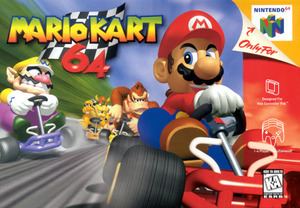
Changes from the original include the move to polygon-based true 3D computer graphics for track design, and the inclusion of four-player support. Players take control of characters from the Mario universe, who race around a variety of tracks with items that can either harm opponents or aid the user. The move to three-dimensional graphics allowed for track features not possible with the original game's Mode 7 graphics, such as changes in elevation, bridges, walls, and pits. However, the characters and items remained 2D pre-rendered sprites.
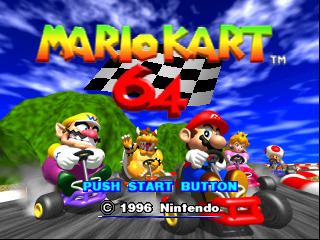
Mario kart 64 n64 teens react retro gaming
Gameplay
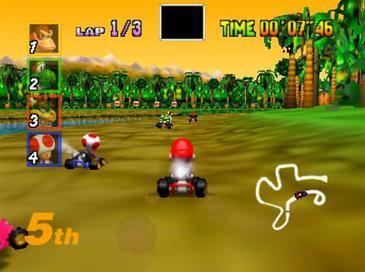
Mario Kart 64 is a kart racing game in which the player controls one of eight selectable Mario characters who race in karts in different race tracks that vary in shape and theme. During a race, the players can obtain random items from special boxes placed in different areas of the track that are used to impede the opposition and gain the advantage. For example, shells and bananas allow the player to attack opponents and slow them down, and Mushrooms grant the player a temporary boost in speed. Mario Kart 64 has 16 race courses and 4 battle courses.
Game modes
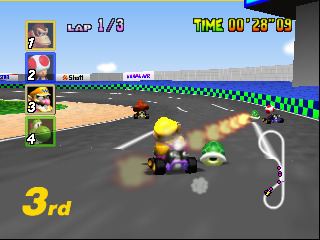
There are four different game modes available in Mario Kart 64: Grand Prix, Time Trial, Versus, and Battle. Grand Prix mode supports both single-player and competitive multiplayer gameplay, while other modes only support one or the other.

Playable characters
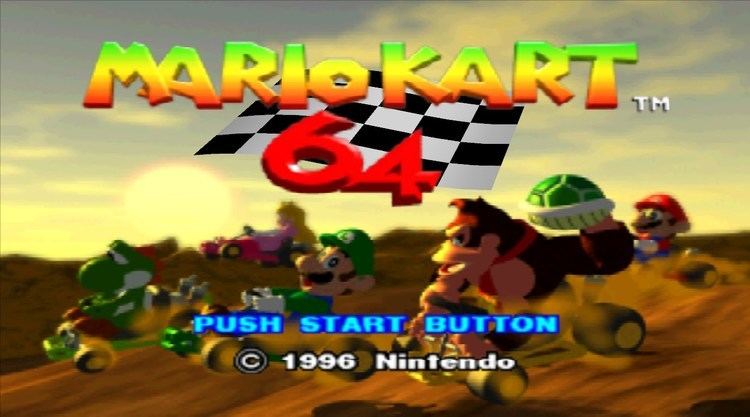
Mario Kart 64 features eight playable characters. Mario, Luigi, Princess Peach, Toad, Yoshi, and Bowser appeared in Super Mario Kart while the remaining two characters, Wario and Donkey Kong, are new to the series replacing Koopa Troopa and Donkey Kong Jr. The characters are divided into three weight classes: lightweights, whose karts have highest acceleration; heavyweight, whose karts have low acceleration and high top speed plus are able to knock around other players; and middleweights, who have normal acceleration and normal top speed.
Development
Production of the game began in 1995 under its original title Super Mario Kart R (the "R" stood for "rendered"), and was intended to be a launch game for the Nintendo 64, but more resources were given to Super Mario 64's development. Some brief early footage of the game was showcased at the Shoshinkai Software Exhibition in Japan on November 24, 1995. According to producer Shigeru Miyamoto, the game was in fact 95 percent complete at the time of the show, but Nintendo chose not to display a playable version due to the difficult logistics of demonstrating the multiplayer features. The prototype featured the Feather item from Super Mario Kart and a Magikoopa as one of the eight playable characters, who was replaced with Donkey Kong in the final game.
The player's driving controls were designed to be similar to operating a radio-controlled car. While Mario Kart 64 features tracks that are fully rendered in 3D, the game uses billboarding to display the characters and items. Game director Hideki Konno stated that, while rendering the characters as 3D models was not impossible, the limited processing power of the console would not have allowed all eight characters to appear on the screen at once. Instead, the characters are composed of pre-rendered sprites that show the characters from various angles to simulate a 3D appearance. Rare Ltd., developer of the Donkey Kong Country games, provided Donkey Kong's character model.
While rubberband AI was used to prevent all the racers from easily separating, the Spiny Shell item, which targets and attacks the player in first place, was added in order to keep each race competitive and balanced. The item was included in all subsequent Mario Kart games.
Soundtrack
The soundtrack for Mario Kart 64 was composed by Kenta Nagata, which was his first work on a Nintendo game. The game's soundtrack was released several times in different formats including Compact Disc and audio cassette. Four different versions of the album were released: Race Tracks and Greatest Hits Soundtrack in North America; Original Soundtrack and Club Circuit were released in Japan. It was later released in a three disc collection, along with the soundtracks of Star Fox 64 and Super Mario 64.
Reception and legacy
Mario Kart 64 received generally positive reviews. IGN stated, "Though the single-player mode is a bit of a step back from the Super Nintendo original, Mario Kart 64 still offers one of the best multiplayer experiences to be had on Nintendo 64." GameSpot insisted that though the graphics and sound of the game are impressive, the gameplay is too easy and lacks depth. In their Virtual Console re-release review, the reviewer criticized its lack of ghost-saving, sound and graphics saying the latter had "aged rather poorly." The game placed 17th in Official Nintendo Magazine's 100 greatest Nintendo games of all time. Mario Kart 64 sold approximately 5.5 million copies in the United States and 2.24 million in Japan. Game Informer reported in June 2014 that the game had sold 9.87 million copies worldwide, making it the second best-selling game on Nintendo 64.
